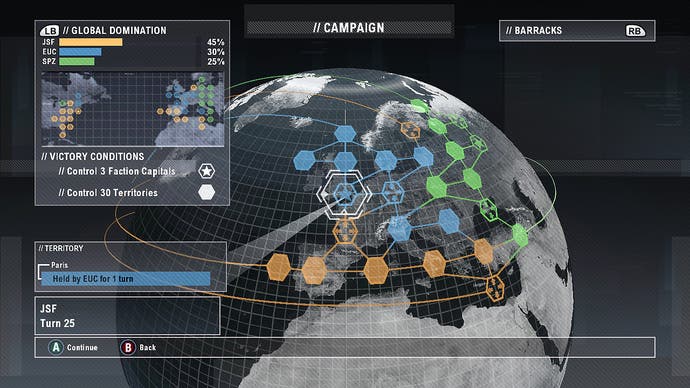Tom Clancy's EndWar
All mouth?
The only thing holding the 360 back here is the lack of a stand, we're told; although we're sure it can't be too hard to knock up a Blue Peter-style job with double-sided sticky tape and unwanted copies of Haze. Aside from that, however, discipline, self-control and consolidation (notwithstanding excitable Mike) are the buzzwords for Team Shanghai.
"We can now debug the game for five months," says Gerighty. "It's a luxury we've never had before at Ubisoft; it's hard to keep going after 3.5 years, but everyone's got their second wind."
To recap briefly, then (a detailed summary of the basics can be found in our preview hands-on, it's 2020 and its the US and Europe versus Russia in a nuclear-powered fight to the death. World War III, to be precise: classic Clancy fodder.
Traditional real-time strategy, of course, typically translates to a console joypad with all the finesse and eloquence of Wayne Rooney doing a turn as Hamlet ("Frailty, thy name is Coleen, eh eh!"). So Ubi Shanghai's Big Idea is voice command. You, as general, control an entire army through voice alone, using the joypad as a walkie-talkie.
This part worked really well last year; it's even better now. During our playtest of a big scrap across Paris in Annihilation Mode, in a noisy conference hall, our orders fail to register only the once. The system has been tweaked, trimmed, topiaried and tousled to the point it is at today, where you can do absolutely everything you need to in-game using the right combination of just 40 words.
"Refining those words is the secret," reckons Gerighty. "We do playtests on this all the time; and if a word has three percent more recognition than another word, we pick it."
What is also immediately obvious are the substantial strides that have been made in bumping up the detail and intensity of battles. The sense of being caught in the midst of a ferocious, multi-faceted battle is compelling and exciting. Still far from fluent in EndWar's combat lexicon, our rather clumsy brain gymnastics produce the desired results after a few seconds' contortion. But watching Gerighty later directing his units swiftly and precisely as a conductor might guide an orchestra through some elaborate symphony of destruction (with all due respect to Megadeth), the potential is enticing.

"Unit 4, secure Foxtrot"; "Deploy artillery"; "Unit 1, upgrade Bravo"; "Calling all gunships, create group"; "Group 1, attack Hostile 6": the orders are pretty straightforward and common-sensical in truth. What might take a little longer to grasp is an appreciation of the entire conflict. It's very easy, as we discover to our substantial loss, to get distracted by watching your choppers batter a bunch of puny soldiers scarpering for cover, zooming right in with a click of the right stick to delight in the death meted out to avatars animated by the same bloke who did Ghost Recon. Meanwhile, the rest of our forces are getting pummelled.
One overwhelmingly positive improvement concerns the camera. Back in December we complained: "You can't help but feel slightly frustrated and cheated that you can't watch your gunships blast the crap out of the enemy from a better angle. It's doubly frustrating when, as happened a couple of times, the fixed view was partially obscured by a building."
Well, the fixed camera has been binned, thank goodness. In its place is a decent range of movement across the x-axis around each unit, which makes finding a satisfying and useful viewpoint a doddle, without buggering up the line-of-sight rule.

